
A croissant is a French pastry made from puff pastry in a crescent shape.
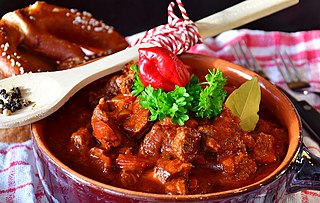
Hungarian or Magyar cuisine is the cuisine characteristic of the nation of Hungary, and its primary ethnic group, the Magyars. Hungarian cuisine has been described as being the spiciest cuisine in Europe. This can largely be attributed to the use of their piquant native spice, Hungarian paprika, in many of their dishes. A mild version of the spice, Hungarian sweet paprika, is commonly used as an alternative. Traditional Hungarian dishes are primarily based on meats, seasonal vegetables, fruits, bread, and dairy products.
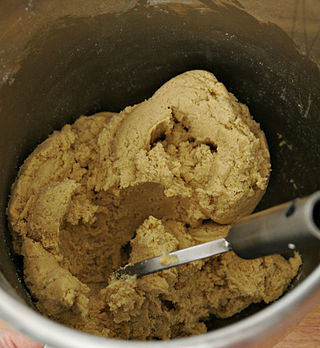
Dough is a thick, malleable, sometimes elastic paste made from grains or from leguminous or chestnut crops. Dough is typically made by mixing flour with a small amount of water or other liquid and sometimes includes yeast or other leavening agents, as well as ingredients such as fats or flavourings.
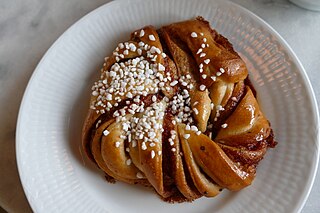
A cinnamon roll is a sweet roll commonly served in Northern Europe and North America. In Sweden it is called kanelbulle, in Denmark it is known as kanelsnegl, in Norway it is known as kanelbolle, skillingsbolle, kanelsnurr, or kanel i svingene, in Finland it is known as korvapuusti, in Iceland it is known as kanilsnúður, and in Estonia it is known as kaneelirull. In Austria and Germany, it is called Zimtschnecke. In Slovakia and the Czech Republic, it is called škoricové slimáky/skořicoví šneci.
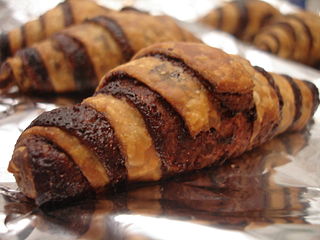
Rugelach is a filled baked confection originating in the Jewish communities of Poland. It is also a popular treat among Jews in the diaspora.
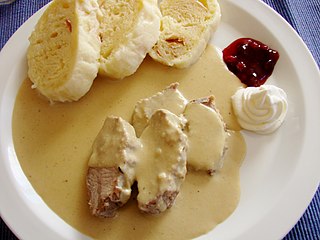
Czech cuisine has both influenced and been influenced by the cuisines of surrounding countries and nations. Many of the cakes and pastries that are popular in Central Europe originated within the Czech lands. Contemporary Czech cuisine is more meat-based than in previous periods; the current abundance of farmable meat has enriched its presence in regional cuisine. Traditionally, meat has been reserved for once-weekly consumption, typically on weekends.

Vanillekipferl are Austrian, German, Swiss, Czech, Slovak, Polish and Hungarian small, crescent-shaped biscuits. They were originally made with walnuts, but almonds or hazelnuts can also be used. They get their typical flavour from a heavy dusting of vanilla sugar.
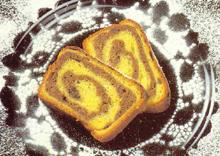
A nut roll is a pastry consisting of a sweet yeast dough that is rolled out very thin, spread with a nut paste made from ground nuts and a sweetener like honey, then rolled up into a log shape. This 'log' is either left long and straight or is often bent into a horseshoe shape, egg washed, baked, and then sliced crosswise. Nut rolls resemble a jelly roll but usually with more layers of dough and filling, and resemble strudels but with fewer and less delicate dough layers. Fillings commonly have as their main ingredient ground walnuts or poppy seeds.

Gata is an Armenian pastry or sweet bread. There are many variations of gata in Armenia. Typically, specific towns or regions will have their own version. It can be found in a variety of shapes, sizes and may be decorated or left unadorned. Long ago, gata was baked in a tonir, but it is now baked in ovens. The bread is traditionally eaten at the feast of Candlemas, but is eaten during other festivities too or simply baked to enjoy with a cup of tea or coffee.
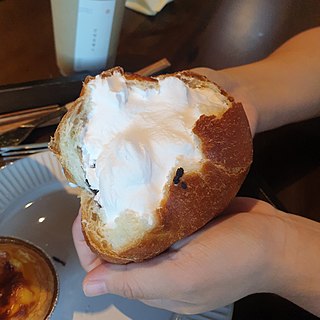
Variations of cream buns or cream rolls exist all around the world. Typically they are made with an enriched dough bread roll that is split after baking and cooling and filled with cream.

Viennoiseries are French baked goods made from a yeast-leavened dough in a manner similar to bread, or from puff pastry, but with added ingredients, which give them a richer, sweeter character that approaches that of pastry. The dough is often laminated.
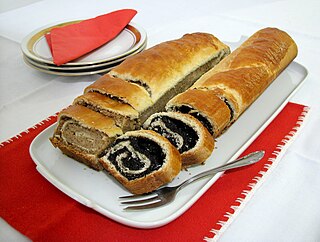
The poppy seed roll is a pastry consisting of a roll of sweet yeast bread with a dense, rich, bittersweet filling of poppy seed. An alternative filling is a paste of minced walnuts, or minced chestnuts.

Pogača is a type of bread baked in the ashes of the fireplace, and later in modern ovens. Found in the cuisines of the Balkans, Levant, and Hungary it can be leavened or unleavened, though the latter is considered more challenging to make. It is generally made from wheat flour, but barley and sometimes rye may be added. It can be stuffed with potatoes, ground beef, olive, or cheese, and have grains and herbs like sesame, black nigella seed, or dried dill in the dough or sprinkled on top.

A babka is a sweet braided bread which originated in the Jewish communities of Poland and Ukraine. It is popular in Israel and in the Jewish diaspora. It is prepared with a yeast-leavened dough that is rolled out and spread with a filling such as chocolate, cinnamon, fruit, or cheese, then rolled up and braided before baking.


































